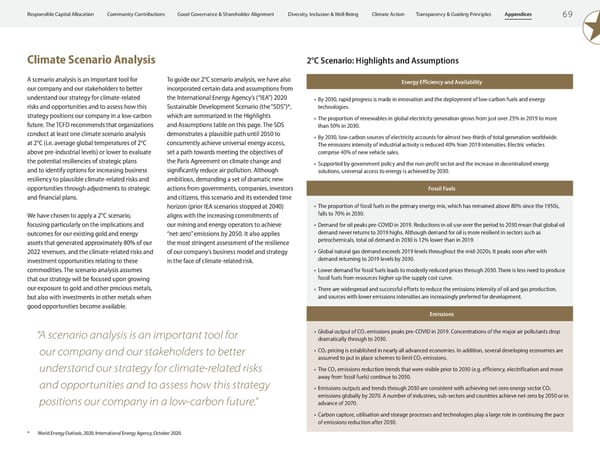Responsible Capital Allocation Community Contributions Good Governance & Shareholder Alignment Diversity, Inclusion & Well-Being Climate Action Transparency & Guiding Principles Appendices 69 Climate Scenario Analysis 2°C Scenario: Highlights and Assumptions A scenario analysis is an important tool for To guide our 2°C scenario analysis, we have also Energy Efficiency and Availability our company and our stakeholders to better incorporated certain data and assumptions from understand our strategy for climate-related the International Energy Agency’s (“IEA”) 2020 • By 2030, rapid progress is made in innovation and the deployment of low-carbon fuels and energy risks and opportunities and to assess how this Sustainable Development Scenario (the “SDS”)*, technologies. strategy positions our company in a low-carbon which are summarized in the Highlights • The proportion of renewables in global electricity generation grows from just over 25% in 2019 to more future. The TCFD recommends that organizations and Assumptions table on this page. The SDS than 50% in 2030. conduct at least one climate scenario analysis demonstrates a plausible path until 2050 to • By 2030, low-carbon sources of electricity accounts for almost two-thirds of total generation worldwide. at 2°C (i.e. average global temperatures of 2°C concurrently achieve universal energy access, The emissions intensity of industrial activity is reduced 40% from 2019 intensities. Electric vehicles above pre-industrial levels) or lower to evaluate set a path towards meeting the objectives of comprise 40% of new vehicle sales. the potential resiliencies of strategic plans the Paris Agreement on climate change and • Supported by government policy and the non-profit sector and the increase in decentralized energy and to identify options for increasing business significantly reduce air pollution. Although solutions, universal access to energy is achieved by 2030. resiliency to plausible climate-related risks and ambitious, demanding a set of dramatic new opportunities through adjustments to strategic actions from governments, companies, investors Fossil Fuels and financial plans. and citizens, this scenario and its extended time horizon (prior IEA scenarios stopped at 2040) • The proportion of fossil fuels in the primary energy mix, which has remained above 80% since the 1950s, We have chosen to apply a 2°C scenario, aligns with the increasing commitments of falls to 70% in 2030. focusing particularly on the implications and our mining and energy operators to achieve • Demand for oil peaks pre-COVID in 2019. Reductions in oil use over the period to 2030 mean that global oil outcomes for our existing gold and energy “net-zero” emissions by 2050. It also applies demand never returns to 2019 highs. Although demand for oil is more resilient in sectors such as assets that generated approximately 80% of our the most stringent assessment of the resilience petrochemicals, total oil demand in 2030 is 12% lower than in 2019. 2022 revenues, and the climate-related risks and of our company’s business model and strategy • Global natural gas demand exceeds 2019 levels throughout the mid-2020s. It peaks soon after with investment opportunities relating to these in the face of climate-related risk. demand returning to 2019 levels by 2030. commodities. The scenario analysis assumes • Lower demand for fossil fuels leads to modestly reduced prices through 2030. There is less need to produce that our strategy will be focused upon growing fossil fuels from resources higher up the supply cost curve. our exposure to gold and other precious metals, • There are widespread and successful efforts to reduce the emissions intensity of oil and gas production, but also with investments in other metals when and sources with lower emissions intensities are increasingly preferred for development. good opportunities become available. Emissions • Global output of CO emissions peaks pre-COVID in 2019. Concentrations of the major air pollutants drop “A scenario analysis is an important tool for 2 dramatically through to 2030. our company and our stakeholders to better • CO2 pricing is established in nearly all advanced economies. In addition, several developing economies are assumed to put in place schemes to limit CO emissions. 2 • The CO emissions reduction trends that were visible prior to 2030 (e.g. efficiency, electrification and move understand our strategy for climate-related risks 2 and opportunities and to assess how this strategy away from fossil fuels) continue to 2050. • Emissions outputs and trends through 2030 are consistent with achieving net-zero energy sector CO2 positions our company in a low-carbon future.” emissions globally by 2070. A number of industries, sub-sectors and countries achieve net-zero by 2050 or in advance of 2070. • Carbon capture, utilisation and storage processes and technologies play a large role in continuing the pace of emissions reduction after 2030. * World Energy Outlook, 2020, International Energy Agency, October 2020.
 2023 ESG Report | Franco-Nevada Page 70 Page 72
2023 ESG Report | Franco-Nevada Page 70 Page 72